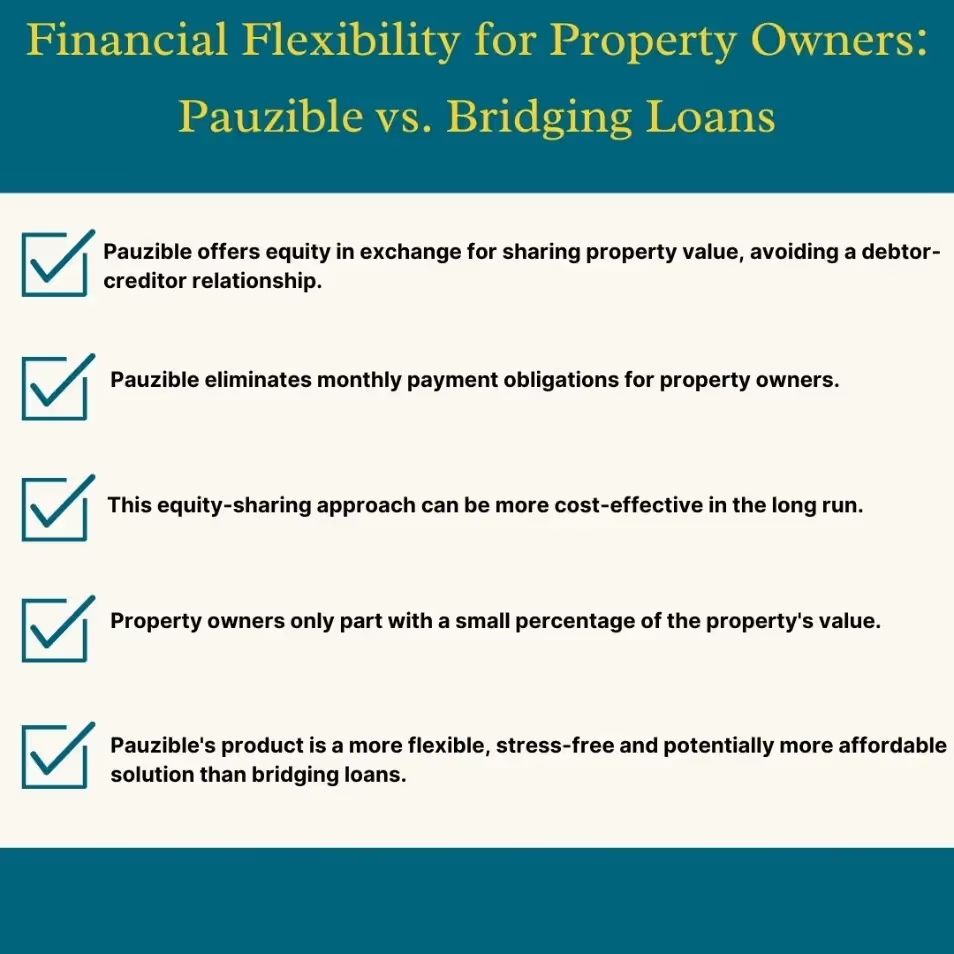
Bridging loans are short-term financing solutions, lasting anywhere from a few weeks to a couple of years. They are particularly useful in the property market, where they are secured against property. While traditional mortgages can take weeks or even months to arrange, bridging loans can be organised much more quickly. This makes them ideal for situations where timing is crucial, such as the need to complete on a property purchased at an auction before a traditional mortgage has been finalised and disbursed, or the need to deal with a break in a chain where the sale of a property has fallen through, but a purchase still needs to be completed. Bridging loans can be, but they come at a cost.
How Much Does a Bridging Loan Cost?
The cost of a bridging loan can vary widely depending on several factors. These include the loan amount, loan term, interest rates and various fees associated with the loan. Generally, the larger the loan and the longer the term, the higher the overall cost.
Bridging loans tend to have higher interest rates than traditional mortgages. Comparison across different lenders is worthwhile to ensure that you are getting the best deal possible.
Interest Rates
Interest rates for bridging loans can range from 0.65% to 1.5% per month but can be higher. The rate you are offered will depend on factors such as the loan-to-value (LTV) ratio , and your credit standing. Higher LTV ratios can result in higher interest rates because they represent a greater risk to the lender. Similarly, a good credit score can help you secure a lower interest rate.
Two Main Types of Bridging Loan
There are several types of bridging loan, each with its own structure and benefits. The two main types are open bridging loans and closed bridging loans. Each has its unique features and implications for the borrower.
Open bridging loans are a flexible form of short-term financing where there is no fixed repayment date. This makes them suitable for borrowers who are unsure when they will be able to repay the loan. Open bridging loans cater to those who may be waiting for their property to be sold or funds to become available from other sources, but without a specific timeline.
While open bridging loans offer greater flexibility, they also come with higher interest rates and fees. Borrowers must provide a clear exit strategy, such as the anticipated sale of a property or the arrangement of long-term financing. This is to reassure lenders of their ability to repay the loan. It is crucial for borrowers to regularly communicate with their lenders and keep them updated on their progress.
Closed bridging loans are short-term financial solutions designed with a fixed repayment date. This makes them ideal for borrowers who have a clear and definite exit strategy. These loans are typically used when the borrower has a confirmed source of funds to repay the loan, such as the imminent completion of the sale of a property with a known date. Because the repayment date is predetermined, closed bridging loans often come with slightly lower interest rates and fees.
. The application process for a closed bridging loan includes demonstrating an exit strategy. This provides lenders with the assurance needed to approve the loan. Despite the lower costs compared to open bridging loans, borrowers should still be aware of the higher interest rates and fees relative to traditional mortgages.
Other Types of Bridging Loans
- Development Bridging Loans: These loans are tailored for property developers who need funds to finance the construction or renovation of a property. Development bridging loans can cover various stages of a project, from initial purchase and planning to construction and finishing. These loans are typically short-term and can be structured to accommodate the unique cash flow requirements of development projects.
- Commercial Bridging Loans: These are designed for businesses or investors looking to purchase commercial properties. Whether it is to secure new business premises, expand existing facilities, or acquire investment properties, commercial bridging loans provide the necessary funds in a short timeframe. This allows businesses to capitalise on opportunities without waiting for long-term financing.
- Auction Bridging Loans: These loans are specifically designed for purchase of properties at auction. They offer quick access to funds needed to complete the purchase within the tight deadlines typically associated with property auctions. These loans ensure buyers can meet the auction conditions, such as paying the deposit immediately and completing the purchase within 28 days.
- Land Bridging Loans: Land bridging loans are specialized short-term financing options designed to help individuals and developers acquire land quickly, often for development purposes. These loans provide the necessary funds to purchase land parcels that may not qualify for traditional mortgages due to the absence of habitable structures or ongoing development. Land bridging loans are particularly useful for property developers who need to secure a piece of land to start or complete a development project before obtaining long-term financing. The terms typically range from a few months to a year, with interest rates higher than conventional loans. Borrowers are expected to have a clear exit strategy, such as selling the developed land, refinancing with a long-term mortgage, or securing additional investment. This type of loan enables developers to act quickly on lucrative land opportunities without being held back by the lengthy approval processes of traditional lenders.
- Refinancing Bridging Loans: These loans are used to bridge the refinancing of existing debt, providing borrowers with the opportunity to replace an existing long-term loan with a new one. Refinancing bridging loans can be used as a bridge to secure better terms, lower interest rates , or consolidate multiple debts into a single loan.
- Second Charge Bridging Loans: These loans are secured against a property that already has an existing mortgage or loan. Second charge bridging loans allow borrowers to access additional funds without refinancing their primary mortgage. This type of loan can be useful for homeowners looking to raise capital for various purposes. These funds can be used for home improvements or debt consolidation, all while keeping the primary mortgage in place.
- Residential Bridging Loans: Residential bridging loans are designed to help homeowners transition smoothly between properties. These loans provide short-term financing to cover the purchase of a new home before the existing property is sold. They are particularly useful in situations involving property chains or auctions. Residential bridging loans allow borrowers to secure a new property quickly and repay the loan once their previous home is sold or long-term financing is arranged.
- First Charge Bridging Loan: A first charge bridging loan is secured against a property as the primary or first charge. This means it takes precedence over any other mortgages or loans on that property. This type of loan is typically used when the property is either mortgage-free or the existing mortgage is being fully repaid by the bridging loan. Because the lender has the first claim on the property in case of default, first-charge bridging loans may offer more favourable terms, such as lower interest rates, compared to second-charge loans.
- Regulated Bridging Loans: Regulated bridging loans involves additional consumer protection required by the Financial Conduct Authority. These loans are typically used for residential properties where the borrower or an immediate family member resides. They are often used when there is a delay in a property sale. Regulated bridging loans must adhere to stricter lending criteria and consumer protection regulations to ensure that borrowers are treated fairly throughout the loan process.
- Unregulated bridging loans: Unregulated bridging loans are not subject to the same level of consumer protection regulations and are generally used for buy-to-let or commercial properties. These loans offer more flexibility in terms of lending criteria and usage. Borrowers of unregulated bridging loans should conduct thorough due diligence and understand the terms and conditions fully to avoid any potential pitfalls.
- Refurbishing Bridging Loans: Refurbishing bridging loans provide short-term finance for property owners looking to renovate or refurbish a property before selling it or securing long-term financing. These loans can cover costs related to structural repairs, cosmetic improvements or significant renovations. By using a refurbishing bridging loan, property owners can increase the property's value and appeal, facilitating a quicker sale thereafter or better mortgage terms once the refurbishment is complete.
- Bridging to Let Loan: A bridging to let loan is designed for investors who plan to purchase a property, renovate it if necessary and then rent it out. This type of loan provides short-term funding to acquire and prepare the property for letting, following which the borrower can transition to a buy-to-let mortgage. Bridging to let loans are particularly useful for investors aiming to expand their rental property portfolio quickly.
- Bridging to Sell Loan: Bridging to sell loans cater to property owners who intend to buy, refurbish, and then sell a property within a short timeframe. These loans provide the necessary capital to purchase and improve the property. This enables a quick resale at a potentially higher price. Bridging to sell loans are usually desirable for property developers and investors who are looking to capitalise on market opportunities and generate profits through property sales.
Comparing Bridging Loans
When comparing bridging loans, there are several factors that must be considered. Interest rates are a primary concern, but you should also look at the fees associated with each loan. Arrangement fees, exit fees, and valuation fees can all add to the overall cost. Another important aspect to consider is the repayment terms. Understanding the flexibility and terms of repayment can help you choose a loan that fits your financial situation. Researching the lender's reputation and customer service can also provide insights into what you can expect during the loan process.
Fees Associated with Bridging Loans
Bridging loans come with several fees that can have a significant impact on their total cost. Arrangement fees are typically charged by the lender for setting up the loan and can range from 1% to 2% of the loan amount. Exit fees, which some lenders charge when you repay the loan, can also add to the cost. These are usually around 1% of the loan amount, but vary by lender.
Valuation fees cover the cost of valuing the property being used as security for the loan. These fees vary based on the property's value and the lender's requirements. There are also legal fees to consider, as both the lender's and borrowers' legal costs need to be covered.
Terms Associated with Bridging Loans
Bridging loans typically last from a few weeks or months to about 12 to 24 months, depending on the lender's policies and the borrower's specific needs. The most common loan terms range between 3 to 12 months. These loans are designed as short-term solutions to provide immediate access to funds, allowing borrowers to bridge financial gaps while awaiting longer-term financing or the sale of an existing property. It is essential for borrowers to have a clear exit strategy, such as selling a property or securing a traditional mortgage, to ensure the loan is repaid within the agreed timeframe.
PAUZIBLE: An Innovative Alternative to a Bridging Loan
Pauzible's model aligns the interests of the property owner and Pauzible by providing access to equity in return for sharing in the property's value, creating a partnership dynamic rather than a traditional debtor-creditor relationship. Using Pauzible's equity access product offers several advantages over a bridging loan. One of the primary benefits is the elimination of any monthly payment obligations. This provides property owners with greater financial flexibility and reduces their cash flow burden. This equity-sharing approach can be more cost-effective in the long run, especially in a rising property market, as property owners’ part with only a small percentage of the property's value, rather than incurring high -interest costs. Overall, Pauzible's product offers a more flexible, stress-free and potentially more affordable financing solution compared to conventional bridging loans.

FAQ’s
Q. What is the typical interest rate for a bridging loan?
A. The typical interest rate for a bridging loan can range from 0.65% to 1.5% per month but can be higher.
Q. What are the differences between open and closed bridging loans?
A. Open bridging loans do not have a fixed repayment date and are more flexible, but they can be more expensive. Closed bridging loans have a fixed repayment date and are usually less expensive.
Q. What fees should I expect to pay for a bridging loan?
A. You should expect to pay arrangement fees, valuation fees, legal fees and exit fees.
Q. How long can a bridging loan term be?
A. Bridging loan terms can last from a few weeks to up to two years.
Q. How does the loan-to-value ratio affect my bridging loan?
A. Higher loan-to-value ratios can lead to higher interest rates because they are riskier for lenders.










